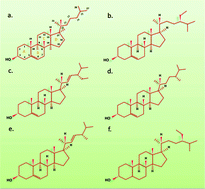We have studied the influence of some major phytosterols on the structure and phase behavior of 1,2-dipalmitoyl-sn-glycero-3-phosphocholine (DPPC) and 1-palmitoyl-2-oleoyl-sn-glycero-3-phosphoethanolamine (POPE) membranes. Phase diagrams of the binary systems have been determined from X-ray diffraction data. All DPPC–phytosterol membranes studied exhibit a sterol-induced modulated phase (Pβ) below the main transition, first reported in DPPC–cholesterol membranes. Structural features of this phase have been deduced from electron density maps calculated from the diffraction data. In addition, a re-entrant ripple phase is observed in DPPC–stigmasterol membranes as a function of temperature. The increase in the bilayer thickness in the fluid phase, due to the ordering of the lipid chains by the sterol molecules, has also been determined from the electron density profiles of the bilayers. All the phytosterols studied are found to increase the bilayer thickness, but to a lower extent compared to cholesterol. Some of the phytosterols phase separate from POPE even at very low concentrations, whereas the others have a similar effect on the phase behavior of POPE, with the temperature range over which the fluid lamellar phase occurs first decreasing and then increasing with increasing phytosterol concentration.

